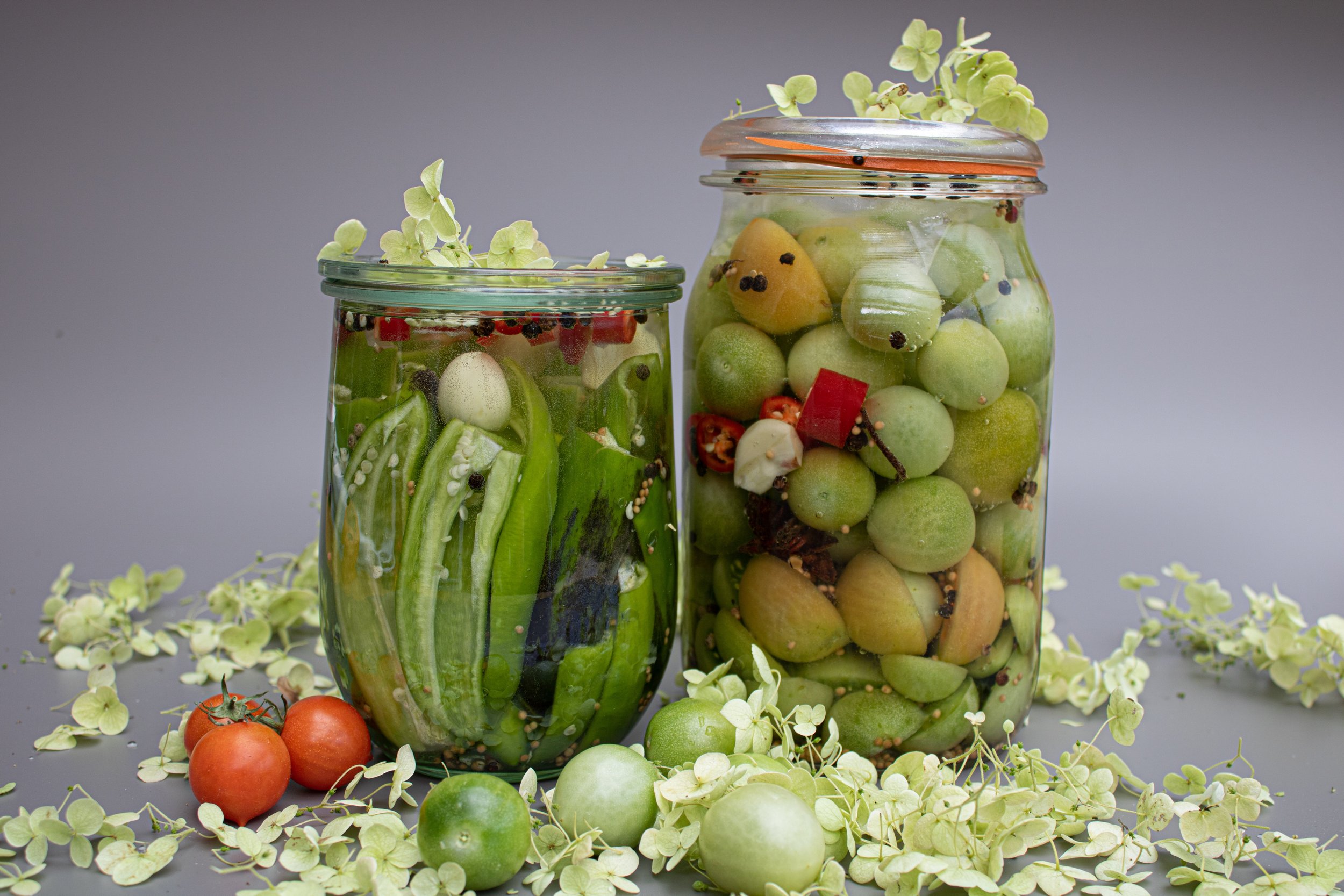Why Eating Fermented Foods Benefits You and Your Gut - And How to Eat More
If someone told you there was a natural, inexpensive, non-prescription way to boost your mood, modulate your weight, and avoid getting sick, I bet you’d be quite interested! Well, I’m here to tell you there is! And all you have to do is get a bit of fermented food in your diet each day. Wondering how to pack a peck of pickled peppers into your diet? In this post, I have put together a list of the most common fermented foods and their benefits, including the low FODMAP serving of each.
Eating Fermented Foods:
-
Adding fermented foods to your diet increases the number of beneficial bacteria in your gut. Some of those beneficial bacterial convert to hormones such as Serotonin (the happy hormone) which helps boost your mood. A healthy gut full of beneficial bacteria contributes to and supports your mental health and cognitive function – think improved memory and concentration!
-
Eating fermented foods can increase your antibodies which protect you against invading pathogens naturally improving your immunity.
-
Eating fermented foods can help regulate your hunger hormones, which in turn can help to control your weight. Adding fermented foods to your diet may also help reduce sugar and carbohydrate cravings too!
-
Adding fermented foods to your diet can make the nutrients more bio-available and more digestible so your gut doesn’t have to work so hard to get the most out of what you eat.
-
Adding fermented foods to your diet can help reduce systemic inflammation. Reducing inflammation can help with chronic diseases such as arthritis and cardiovascular disease. It can also help offset inflammatory lifestyle factors such as poor diet, excess caffeine, overconsumption of sugar, certain medications, etc.
Some common fermented foods—and Low FODMAP servings
Yogurt (lactose-free) - Low FODMAP Serving Size: 6 ounces
Yogurt is one of the most popular and common fermented products available today. Be sure to choose organic whenever possible. Also look for natural, and probiotic-rich yogurt for maximum health benefits. And of course, steer clear of the highly sugared yogurt parfaits. Plain lactose-free yogurt with some nuts, homemade granola, or fruit on it is ideal. Vegans (or those who don’t tolerate the whey in milk) can try coconut yogurt made with organic coconut milk fermented with probiotic starter.
Kombucha - Low FODMAP Serving Size: 6 ounces
A very popular fermented tea drink that uses a colony of yeast and bacteria known as a SCOBY (Symbiotic Culture of Bacteria and Yeast). It might not sound very good, but tastes delicious! It can be flavored with different fruits and spices to create a mildly fizzy, gut-loving, highly beneficial, delicious drink. Look for one that doesn’t have added sugar (it will always be fermented with fruit or something that has sugar anyway). My favorite is GT’s Marine Greens which is fermented with Kiwi juice and tea. As it contains some a small amount of caffeine even after fermenting, it’s important to adjust the serving size to your tolerance and have it early in the day!
Kefir (lactose-free) - Low FODMAP Serving Size: 8 ounces (or 1 Tablespoon of traditional Kefir with Lactose)
Milk kefir is a tart, drinkable, natural yogurt. It contains many beneficial probiotics and is high in Vitamin B12, calcium, and magnesium. It can easily be added to smoothies for a simple probiotic boost. Water kefir is just as beneficial and is ideal for vegans. It is made from grains and can be flavored in a similar way to Kombucha.
Apple Cider Vinegar - Low FODMAP Serving Size: 2 Tablespoons
Apple Cider Vinegar (ACV) contains acetic acid which supports the function of probiotics and prebiotics in your gut. It is ideal as a blood sugar balancer and digestive aid. Mix it into salad dressings, soups, and sauces, or add a teaspoon to a glass of warm water before meals to help with digestion. ACV contains important digestive enzymes. Taken before bed, it can have a positive effect on morning fasting blood sugars.
Here’s an article I wrote about taking ACV as a supplement while on a low FODMAP diet.
Sourdough Bread - Low FODMAP Serving Size: 1 Slice (.92 ounces)
The long fermentation process involved in making sourdough bread helps to make nutrients found in the grains, more available for absorption and reduces the antinutrient content that may make digestion difficult. Those with gluten sensitivity, who might usually experience bloating and indigestion when eating regular bread, may have little or no digestive symptoms when eating real sourdough bread. To identify “real” sourdough bread, it must not include commercial yeast or vinegar in the list of ingredients. These are used to create bread that tastes like sourdough but is not actually fermented. If you go to your local bakery, where you’ll find the absolute best sourdough bread, you can ask to confirm it is made in the traditional way with a long period of fermentation.
Miso - Low FODMAP Serving Size: 1 Tablespoon
Miso is a soybean paste that is made from brown rice or barley fermented with a type of fungus called Koji. Traditionally used in Asian recipes, as a base for soup, it’s a great flavor enhancer and probiotic food booster. Try adding it to salad dressings along with apple cider vinegar and to soups and stews. There are multiple varieties (all good!) and you can buy them in most grocery stores. You can also make it yourself (if you don’t mind waiting at least 12 months for it to mature!)
Sauerkraut - Low FODMAP Serving Size: 1 Tablespoon
Traditionally made from white cabbage, it can also be made with red cabbage, fennel, and other vegetables. Sauerkraut is rich in fiber, B vitamins, Vitamin K, and Vitamin C. It’s also an excellent source of trace minerals which are important for blood clotting and healthy bones. Simply add a spoonful of sauerkraut to your salads or soups 3-4 times per week for optimum health benefits.
Sauerkraut is extremely cheap and easy to make. Want to make your own? Here’s an excellent how-to article from which much of this content was derived.
Kimchi - Low FODMAP Serving Size: 1/4 cup (1.66 ounces)
Kimchi is a Korean delicacy dating all the way back to the 7th century. It is a spicy version of sauerkraut that is typically made with Chinese leaves, garlic, ginger, and chilies (so read the ingredients before diving in and look for one without the garlic.) These add potent anti-inflammatory properties as well as antioxidants to the probiotic benefits. It can be added to your next stir-fry or soup for a strong flavor boost.
Tempeh (plain) - Low FODMAP Serving Size: 1 Slice (3.5 ounces)
Tempeh is made from whole fermented soybeans, to create a very dense, cake-like product that contains more probiotics and health benefits than the more well-known soybean-based food, Tofu. It is more textured than tofu, chewier, and much higher in protein. It can be used as a meat substitute. It’s sometimes hard to find plain tempeh so watch for FODMAP ingredients used to flavor the tempeh.
Tofu (firm/drained) - Low FODMAP Serving Size: 1 Cup
Tofu is also made from fermented soybeans and it can easily absorb flavors which makes it very versatile in recipes. It is a great source of protein important for the growth and repair of tissues. It also contains Phyto-estrogen compounds – important for hormone balancing (particularly in menopause). If possible, always choose non-GMO sourced tofu, not the highly processed soy protein isolate you often find in the grocery store. And, for low FODMAP, always use firm tofu (not the silken variety).
Have a question you’d like to have answered? Email me at hello@ibsgamechanger.com






























